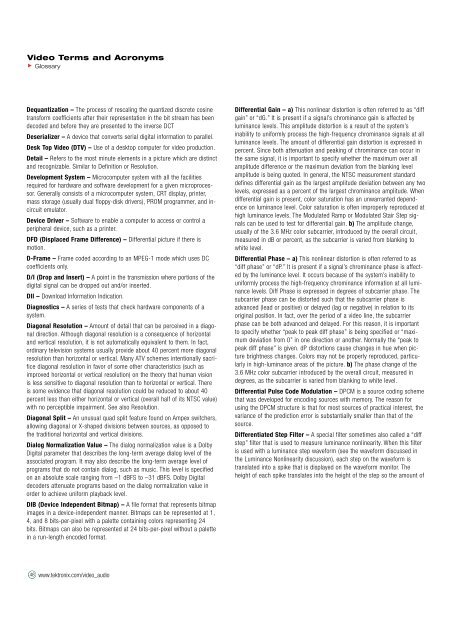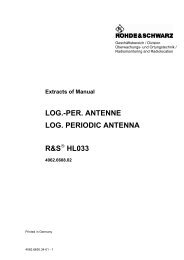Glossary of Video Terms and Acronyms - Isotest
Glossary of Video Terms and Acronyms - Isotest
Glossary of Video Terms and Acronyms - Isotest
You also want an ePaper? Increase the reach of your titles
YUMPU automatically turns print PDFs into web optimized ePapers that Google loves.
<strong>Video</strong> <strong>Terms</strong> <strong>and</strong> <strong>Acronyms</strong><br />
<strong>Glossary</strong><br />
Dequantization – The process <strong>of</strong> rescaling the quantized discrete cosine<br />
transform coefficients after their representation in the bit stream has been<br />
decoded <strong>and</strong> before they are presented to the inverse DCT<br />
Deserializer – A device that converts serial digital information to parallel.<br />
Desk Top <strong>Video</strong> (DTV) – Use <strong>of</strong> a desktop computer for video production.<br />
Detail – Refers to the most minute elements in a picture which are distinct<br />
<strong>and</strong> recognizable. Similar to Definition or Resolution.<br />
Development System – Microcomputer system with all the facilities<br />
required for hardware <strong>and</strong> s<strong>of</strong>tware development for a given microprocessor.<br />
Generally consists <strong>of</strong> a microcomputer system, CRT display, printer,<br />
mass storage (usually dual floppy-disk drivers), PROM programmer, <strong>and</strong> incircuit<br />
emulator.<br />
Device Driver – S<strong>of</strong>tware to enable a computer to access or control a<br />
peripheral device, such as a printer.<br />
DFD (Displaced Frame Difference) – Differential picture if there is<br />
motion.<br />
D-Frame – Frame coded according to an MPEG-1 mode which uses DC<br />
coefficients only.<br />
D/I (Drop <strong>and</strong> Insert) – A point in the transmission where portions <strong>of</strong> the<br />
digital signal can be dropped out <strong>and</strong>/or inserted.<br />
DII – Download Information Indication.<br />
Diagnostics – A series <strong>of</strong> tests that check hardware components <strong>of</strong> a<br />
system.<br />
Diagonal Resolution – Amount <strong>of</strong> detail that can be perceived in a diagonal<br />
direction. Although diagonal resolution is a consequence <strong>of</strong> horizontal<br />
<strong>and</strong> vertical resolution, it is not automatically equivalent to them. In fact,<br />
ordinary television systems usually provide about 40 percent more diagonal<br />
resolution than horizontal or vertical. Many ATV schemes intentionally sacrifice<br />
diagonal resolution in favor <strong>of</strong> some other characteristics (such as<br />
improved horizontal or vertical resolution) on the theory that human vision<br />
is less sensitive to diagonal resolution than to horizontal or vertical. There<br />
is some evidence that diagonal resolution could be reduced to about 40<br />
percent less than either horizontal or vertical (overall half <strong>of</strong> its NTSC value)<br />
with no perceptible impairment. See also Resolution.<br />
Diagonal Split – An unusual quad split feature found on Ampex switchers,<br />
allowing diagonal or X-shaped divisions between sources, as opposed to<br />
the traditional horizontal <strong>and</strong> vertical divisions.<br />
Dialog Normalization Value – The dialog normalization value is a Dolby<br />
Digital parameter that describes the long-term average dialog level <strong>of</strong> the<br />
associated program. It may also describe the long-term average level <strong>of</strong><br />
programs that do not contain dialog, such as music. This level is specified<br />
on an absolute scale ranging from –1 dBFS to –31 dBFS. Dolby Digital<br />
decoders attenuate programs based on the dialog normalization value in<br />
order to achieve uniform playback level.<br />
DIB (Device Independent Bitmap) – A file format that represents bitmap<br />
images in a device-independent manner. Bitmaps can be represented at 1,<br />
4, <strong>and</strong> 8 bits-per-pixel with a palette containing colors representing 24<br />
bits. Bitmaps can also be represented at 24 bits-per-pixel without a palette<br />
in a run-length encoded format.<br />
48 www.tektronix.com/video_audio<br />
Differential Gain – a) This nonlinear distortion is <strong>of</strong>ten referred to as “diff<br />
gain” or “dG.” It is present if a signal’s chrominance gain is affected by<br />
luminance levels. This amplitude distortion is a result <strong>of</strong> the system’s<br />
inability to uniformly process the high-frequency chrominance signals at all<br />
luminance levels. The amount <strong>of</strong> differential gain distortion is expressed in<br />
percent. Since both attenuation <strong>and</strong> peaking <strong>of</strong> chrominance can occur in<br />
the same signal, it is important to specify whether the maximum over all<br />
amplitude difference or the maximum deviation from the blanking level<br />
amplitude is being quoted. In general, the NTSC measurement st<strong>and</strong>ard<br />
defines differential gain as the largest amplitude deviation between any two<br />
levels, expressed as a percent <strong>of</strong> the largest chrominance amplitude. When<br />
differential gain is present, color saturation has an unwarranted dependence<br />
on luminance level. Color saturation is <strong>of</strong>ten improperly reproduced at<br />
high luminance levels. The Modulated Ramp or Modulated Stair Step signals<br />
can be used to test for differential gain. b) The amplitude change,<br />
usually <strong>of</strong> the 3.6 MHz color subcarrier, introduced by the overall circuit,<br />
measured in dB or percent, as the subcarrier is varied from blanking to<br />
white level.<br />
Differential Phase – a) This nonlinear distortion is <strong>of</strong>ten referred to as<br />
“diff phase” or “dP.” It is present if a signal’s chrominance phase is affected<br />
by the luminance level. It occurs because <strong>of</strong> the system’s inability to<br />
uniformly process the high-frequency chrominance information at all luminance<br />
levels. Diff Phase is expressed in degrees <strong>of</strong> subcarrier phase. The<br />
subcarrier phase can be distorted such that the subcarrier phase is<br />
advanced (lead or positive) or delayed (lag or negative) in relation to its<br />
original position. In fact, over the period <strong>of</strong> a video line, the subcarrier<br />
phase can be both advanced <strong>and</strong> delayed. For this reason, it is important<br />
to specify whether “peak to peak diff phase” is being specified or “maximum<br />
deviation from 0” in one direction or another. Normally the “peak to<br />
peak diff phase” is given. dP distortions cause changes in hue when picture<br />
brightness changes. Colors may not be properly reproduced, particularly<br />
in high-luminance areas <strong>of</strong> the picture. b) The phase change <strong>of</strong> the<br />
3.6 MHz color subcarrier introduced by the overall circuit, measured in<br />
degrees, as the subcarrier is varied from blanking to white level.<br />
Differential Pulse Code Modulation – DPCM is a source coding scheme<br />
that was developed for encoding sources with memory. The reason for<br />
using the DPCM structure is that for most sources <strong>of</strong> practical interest, the<br />
variance <strong>of</strong> the prediction error is substantially smaller than that <strong>of</strong> the<br />
source.<br />
Differentiated Step Filter – A special filter sometimes also called a “diff<br />
step” filter that is used to measure luminance nonlinearity. When this filter<br />
is used with a luminance step waveform (see the waveform discussed in<br />
the Luminance Nonlinearity discussion), each step on the waveform is<br />
translated into a spike that is displayed on the waveform monitor. The<br />
height <strong>of</strong> each spike translates into the height <strong>of</strong> the step so the amount <strong>of</strong>





